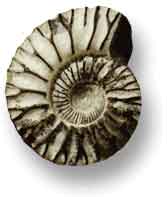Ammonites

Ammonites lived during the periods of Earth history known as the Jurassic and Cretaceous. Together, these represent a time interval of about 140 million years. The Jurassic Period began about 205 million years ago, and the Cretaceous ended about 65 million years ago. The ammonites became extinct at the end of the Cretaceous Period, at roughly the same time as the dinosaurs disappeared.
However, we know a lot about them because they are commonly found as fossils, formed when the remains or traces of the animal became buried sediment that later solidified into rock.

Ammonites were marine animals belonging to the phylum Mollusca and the class Cephalopoda. They had a coiled external shell similar to the modern nautilus. In other living cephalopods, e.g. octopus, squid and cuttlefish, the shells are small and internal, or absent.
The ammonite's shell was divided into chambers separated by walls known as septa (singular septum). These strengthened the shell and stopped it from being crushed by the external water pressure. Ammonites could probably not withstand depths of more than 100 metres.



Ammonites take their name from the Egyptian god Amun, known to the Greeks as Zeus Ammon. This god is depicted on Cyrean coins and in sculpture by a head with curling ram's horns. Many genera of ammonites have names ending in -ceras from the Greek word 'keras' meaning horn.
Early works of natural history compared the coiled form of the ammonite with that of a serpent, and ammonites became widely known as snakestones. In order to perpetuate the legend that ammonites were serpents that had been turned into stone, local collectors and dealers in fossils frequently carved heads on them.